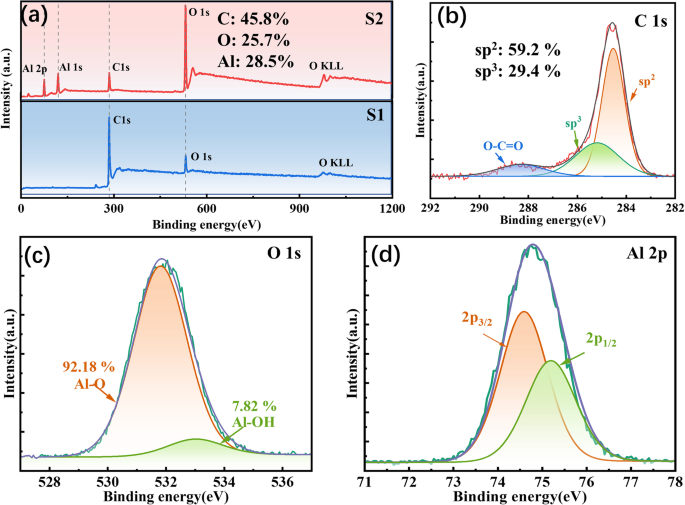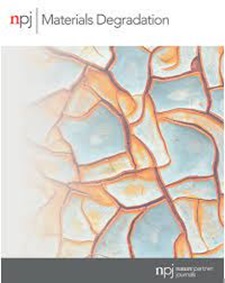Dense Al2O3 sealing inhibited high hydrostatic pressure corrosion of Cr/GLC coating
IF 7.6
2区 材料科学
Q1 MATERIALS SCIENCE, MULTIDISCIPLINARY
引用次数: 0
Abstract
The corrosion failure of amorphous carbon (a-C) coatings is commonly ascribed to the existence of growth microdefects, which serve as pathways for corrosive fluids to permeate the substrate. Atomic layer deposition (ALD) is renowned for its ability to augment the corrosion resistance of metallic materials. Graphite-like carbon (GLC) is one of the amorphous carbon materials dominated by hybridized sp2-C bonds. In this study, an ALD-deposited Al2O3 layer is specially introduced on the Cr/GLC multilayer coating to solve the aforementioned corrosion risk of a-C by taking the sealing conception for defects. Compared to the as-deposited Cr/GLC coating, the coating encapsulated with Al2O3 layer depicts the reduction of corrosion current density over two orders of magnitude under a wide pressure range of 0.1 ~ 15 MPa. Particularly, the presence of released Crn+ and Fen+ in the corrosion solution is significantly diminished, accompanying with a small quantity of Aln+ generated in sealed coating during corrosion. Microstructural analysis and electrochemical results identified that both the dense Al2O3 layer offered strong safeguard for Cr elements released from multilayers, whilst amorphous carbon network inhibited the likelihood chloride penetration induced by partially infiltrated Al2O3, which made the synergistic contributions to the enhancement of corrosion resistance for Cr/GLC coating for deep-sea applications.


致密的 Al2O3 密封材料抑制了 Cr/GLC 涂层的高静水压腐蚀
无定形碳(a-C)涂层的腐蚀失效通常是由于存在生长微缺陷造成的,这些微缺陷是腐蚀性液体渗透基底的通道。原子层沉积(ALD)以其增强金属材料耐腐蚀性的能力而闻名。类石墨碳 (GLC) 是以杂化 sp2-C 键为主的无定形碳材料之一。本研究在铬/GLC 多层涂层上特别引入了 ALD 沉积 Al2O3 层,通过对缺陷的密封概念来解决上述 a-C 的腐蚀风险。与原沉积的 Cr/GLC 涂层相比,封装了 Al2O3 层的涂层在 0.1 ~ 15 MPa 的宽压力范围内,腐蚀电流密度降低了两个数量级以上。特别是,腐蚀溶液中释放的 Crn+ 和 Fen+ 明显减少,同时在腐蚀过程中密封涂层中产生了少量 Aln+。微观结构分析和电化学结果表明,致密的 Al2O3 层为多层中释放的铬元素提供了强有力的保护,而无定形碳网络则抑制了部分渗入的 Al2O3 诱导的氯化物渗透的可能性,两者协同作用,增强了用于深海应用的铬/GLC 涂层的耐腐蚀性能。
本文章由计算机程序翻译,如有差异,请以英文原文为准。
求助全文
约1分钟内获得全文
求助全文
来源期刊

npj Materials Degradation
MATERIALS SCIENCE, MULTIDISCIPLINARY-
CiteScore
7.80
自引率
7.80%
发文量
86
审稿时长
6 weeks
期刊介绍:
npj Materials Degradation considers basic and applied research that explores all aspects of the degradation of metallic and non-metallic materials. The journal broadly defines ‘materials degradation’ as a reduction in the ability of a material to perform its task in-service as a result of environmental exposure.
The journal covers a broad range of topics including but not limited to:
-Degradation of metals, glasses, minerals, polymers, ceramics, cements and composites in natural and engineered environments, as a result of various stimuli
-Computational and experimental studies of degradation mechanisms and kinetics
-Characterization of degradation by traditional and emerging techniques
-New approaches and technologies for enhancing resistance to degradation
-Inspection and monitoring techniques for materials in-service, such as sensing technologies
 求助内容:
求助内容: 应助结果提醒方式:
应助结果提醒方式:


